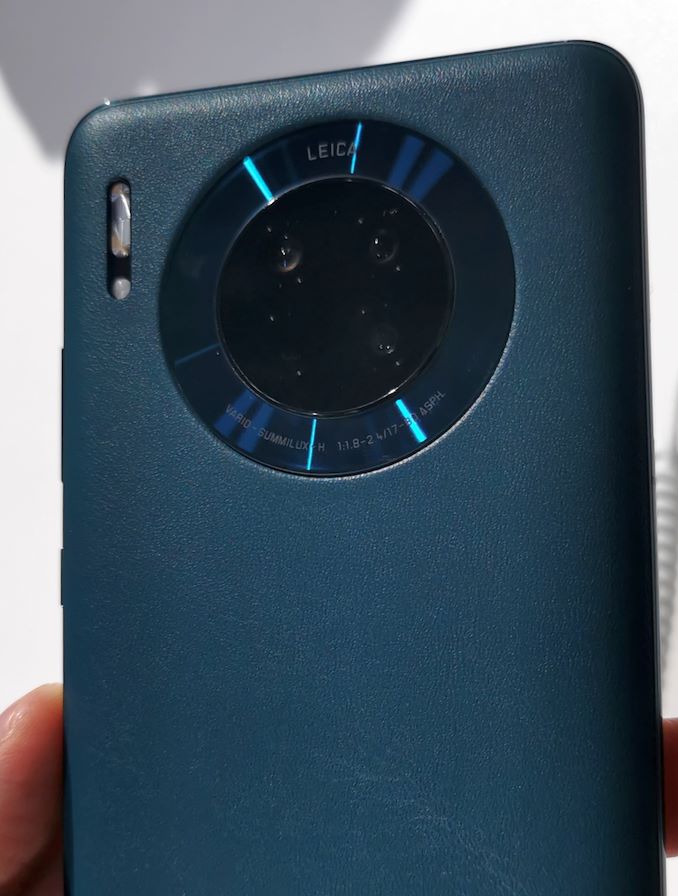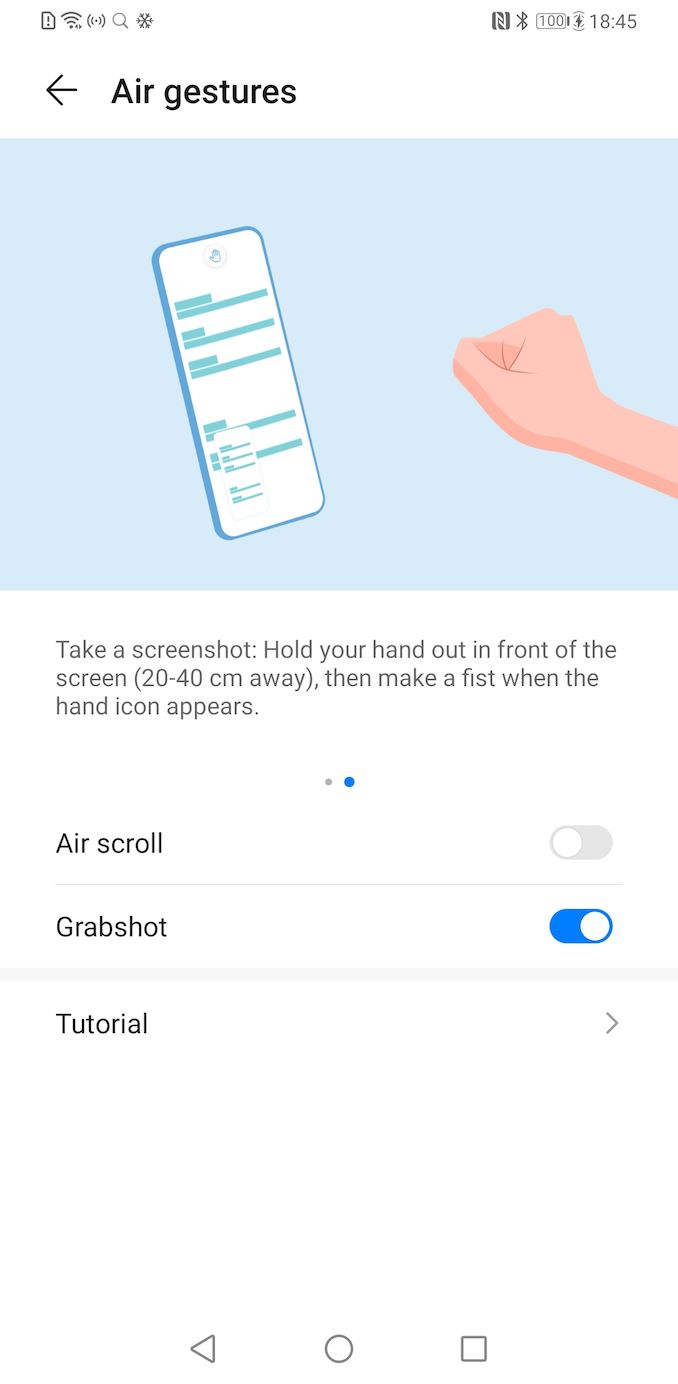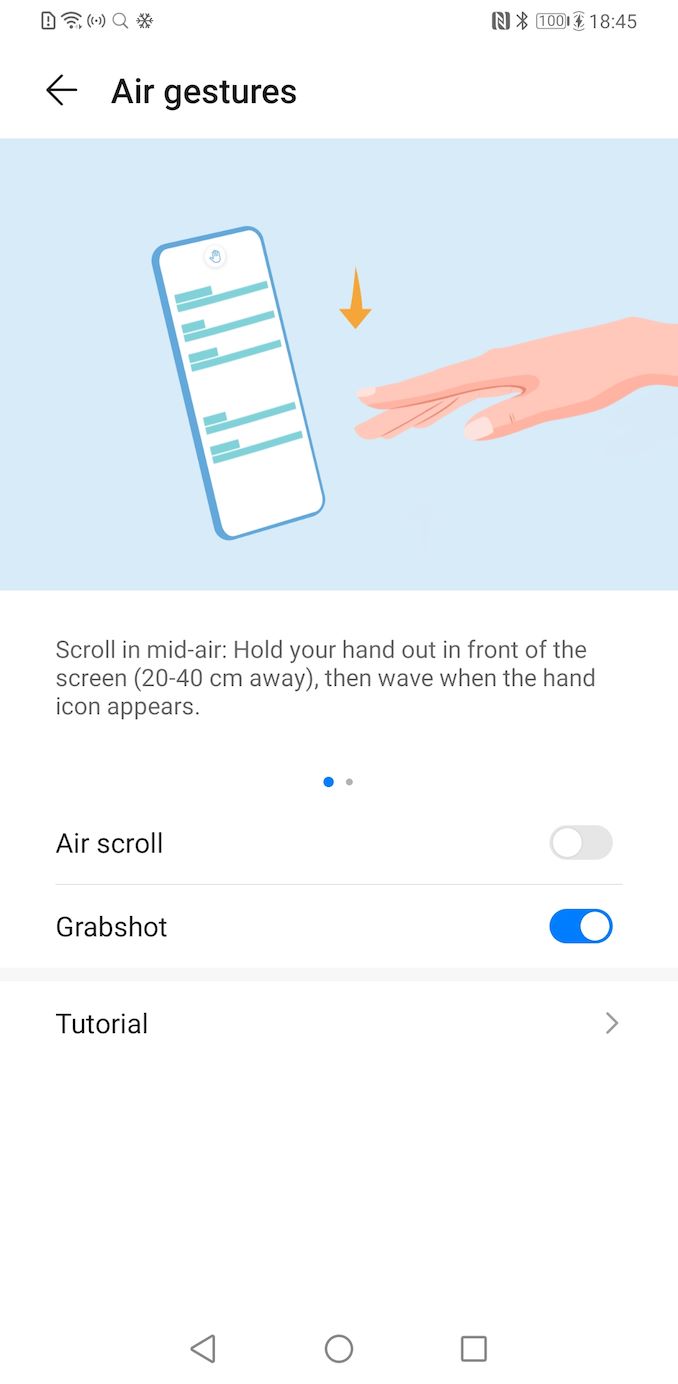A Day with the Huawei Mate 30 Pro: Kirin 990 and 7680 FPS Slow Motion Tests
by Dr. Ian Cutress on September 23, 2019 4:00 AM EST- Posted in
- Smartphones
- Huawei
- Kirin 990
- Mate 30 Pro
- 7680fps
The Technical Details
Inside the device beats the heart of Huawei’s latest silicon design efforts: a HiSilicon Kirin 990 SoC. We’ve covered the SoC in some detail already – we have an eight core design built on TSMC’s 7nm that uses Arm Cortex A76 cores and an Arm Mali G76MP16 GPU. Compared to the previous Kirin 980, these cores have had slight increases, but nothing to write home about. The biggest change is in the NPU for AI processing, where Huawei has changed from its licensed Cambricon design to its own in-house Da Vinci architecture, allowing for full AI network support. Huawei has added in a ‘tiny’ Da Vinci NPU to run super-low-power networks such as voice recognition, and a high-powered ‘large’ Da Vinci NPU for performance related AI such as image detection and enhancement. The CPU, GPU, and NPU, also get an additional layer of cache to help with its speed up.
| Huawei Mate 30 Series | ||||
| AnandTech | Mate 30 | Mate 30 Pro (Mate 30 Pro 5G) |
||
| SoC | HiSilicon Kirin 990 2x Cortex-A76 @ 2.86 GHz 2x Cortex-A76 @ 2.09 GHz 4x Cortex-A55 @ 1.86 GHz |
|||
| (HiSilicon Kirin 990 5G) 2x Cortex-A76 @ 2.86 GHz 2x Cortex-A76 @ 2.36 GHz 4x Cortex-A55 @ 1.95 GHz |
||||
| GPU | Mali G76MP16 @ 600MHz (Mali G76MP16 @ 700MHz) |
|||
| DRAM | 8GB LPDDR4X | 8GB LPDDR4X | ||
| Display | 6.62" OLED 2340 x 1080 (19.5:9) |
6.53" OLED 2400 x 1176 (18.4:9) edge-to-edge |
||
| Size | Height | 160.8 mm | 158.1 mm | |
| Width | 76.1 mm | 73.1 mm | ||
| Depth | 8.4 mm (9.2mm) |
8.8 mm (9.5mm) |
||
| Weight | 196 grams | 198 grams | ||
| Battery Capacity | 4100mAh (Rated) 4200mAh (Typical) 40W charging |
4400mAh (Rated) 4500mAh (Typical) 40W charging |
||
| Wireless Charging | 27W charging + reverse charging | |||
| Rear Cameras | ||||
| Main | 40MP f/1.8 RYYB sensor 27mm equiv. FL |
40MP f/1.6 OIS RYYB sensor 27mm equivl. FL |
||
| Telephoto | 8MP f/2.4 OIS 3x Optical zoom 80mm equiv. FL |
|||
| Wide | 16MP f/2.2 Ulta wide angle 17mm equivl. FL |
40MP f/1.8 RGGB sensor Ultra wide angle 18mm equivl. FL 720p7680fps video capture |
||
| Extra | - | 3D Depth Camera | ||
| Front Camera | 24MP f/2.0 | 32MP f/2.0 | ||
| Storage | 128 / 256GB + proprietary "nanoSD" card |
|||
| I/O | USB-C 3.5mm headphone jack |
USB-C | ||
| Wireless (local) | 802.11ac (Wifi 5), Bluetooth 5.1 |
|||
| Cellular | 4G LTE (4G + 5G NR NSA+SA Sub-6GHz) |
|||
| Splash, Water, Dust Resistance | IP53 (no water resistance) |
IP68 (water resistant up to 1m) |
||
| Dual-SIM | 2x nano-SIM | |||
| Launch OS | Android 10 w/ EMUI 10 without Google services |
|||
| Launch Price | 8+128 GB: 799€ |
8+256 GB: 1099€ (5G 8+256GB: 1199€) |
||
Huawei does have a faster Kirin 990 version on the way, the Kirin 990 5G: this chip is built using 7nm+ EUV, doubles the size of the NPU, but most importantly includes a 5G sub-6 GHz modem on board. This chip will be used in the Mate 30 5G and Mate 30 Pro 5G versions, which are coming out in China this year and select worldwide markets over time. We’re hoping to get hold of the 5G version to see for any quality differences between the 7nm and 7nm+ processes.
The display is a 6.53-inch 2400x1176 Flex OLED display, which comes in at that odd aspect ratio of 18.4:9. This is because of that wrap-around ‘horizon’ display, that comes over the edges. As mentioned on the previous page, some applications ignore these extra sides and act as if the display is a more standard 19:9 to 20:9 display. Huawei states that the display supports the DCI-P3 color space, though does not disclose how much of the gamut it covers, nor the brightness levels of the screen or the accuracy therein.
For the cameras, as mentioned on the previous page, Huawei is positioning the Mate 30 Pro as a premium professional photography assistant device to go alongside more expensive hardware. The three main sensors include a main 40MP f/1.6 OIS RYYB (27mm) sensor, a wide-angle 40MP f/1.8 RGB (18mm) sensor with support up to 7680 fps at 720p, and a final telephoto 8MP f/2.4 OIS with 3x optical zoom. Also included on the rear is a 3D depth camera.
The front camera is a 32MP f/2.0 selfie camera, paired with a proximity sensor, two 3D depth cameras, and a gesture sensor. The two gestures supported include taking a screenshot by making a fist, or scrolling up and down by waving.
The fingerprint sensor is embedded in the display, with Huawei stating that they’re using the latest generation technology. Based on previous Huawei devices, we assume this is a Goodix in-screen fingerprint sensor, which was confirmed via Goodix’s twitter feed. However, when quizzed as to which generation sensor (we know Goodix has at least four), neither Huawei nor Goodix responded to our inquiry.
The battery for the Mate 30 Pro comes in at 4500 mAh, although the company didn’t go into too many details about how long this should last. Huawei is offering the Mate 30 Pro in one main configuration: 8 GB of LPDDR4X-3733 for DRAM, and 256 GB for storage. The device is dual nano-SIM, supporting dual connections, and one of the slots supports Huawei’s proprietary nanoSD card. For the 5G model, both SIM slots can be 5G enabled, although only one at a time. Wi-Fi support is listed as Wi-Fi 5.













47 Comments
View All Comments
pberger - Monday, September 23, 2019 - link
I'm more impressed with the 76'206 AI-Benchmark score of this phone thanks to the new NPU more than twice more performant than the 980 one.Now how this can be compared to desktop GPU scores? Any link?
designerfx - Monday, September 23, 2019 - link
", the bottom left is a 40MP f/1.6 camera with OIS, and the bottom left is an 8MP f/2.4 telephoto camera and lens, also with OIS."might want to specify which bottom left, apparently - or fix your typo
eastcoast_pete - Monday, September 23, 2019 - link
Thanks Ian! Question: how is the reception and call quality of the phone? While I use my smartphones for all kinds of other things, my smartphone is also my main phone, and I had some otherwise good smartphones fail at being good at that - making phone calls. Any impressions?saru44 - Tuesday, September 24, 2019 - link
I am really upset with the direction the smartphone reviews are going! They have so many advanced tools and benchmarks to test the display, processor etc, but they outright skip the most important aspect of a phone to many people - Telephony. There is nothing in the reviews about call quality, ear piece volume levels/ clarity, network reception quality inside buildings/ poor network coverage areas, microphone quality (how good the person sounds to the caller on the other side), etc.. Just nothing!peevee - Tuesday, September 24, 2019 - link
"This does one of two things. Firstly, it affects how we change the volume, as there is no volume button control. In order to adjust the volume, the user double taps on the edge of the display, and the volume pop-up allows the user to swipe up and down, using a thumb on the edge of the display, to adjust the volume"Meaning that:
1) There is no rim, so placing the phone display down will scratch the glass with a grain of sand etc
2) a case cannot protect the sides of the phone as that would disable volume adjustment function.
3) You cannot adjust volume by feel in your pocket/phone holder without taking it out and turning on the screen first.
Stupid designs are stupid.
s.yu - Tuesday, September 24, 2019 - link
I noted the volume issue at GSMA, I said that if the rumors are true (which they turned out to be), then the volume implementation would be a total gimmick. NEX3 has a highly similar screen yet their volume is pressure based, which is compatible with a case.peevee - Tuesday, September 24, 2019 - link
"At 256x however, the video is also 32 seconds, meaning that the sensor can only record 0.125 seconds of video."Useless. Typical reaction time is over 0.3s. Way more when a person is tired. Nobody can catch the event lasting 0.125s.
Somebody needs to start prosecution for false advertisement.
peevee - Tuesday, September 24, 2019 - link
The resolution in the high-fps video is not 720p either, it looks like 160p. Looks like they "interpolate" not just frames but pixels in the frame. All while advertising high fps and high res. Fraudsters.s.yu - Tuesday, September 24, 2019 - link
Wow I was thinking 360p, 160p is.........I think they read out more than that, but it could be a little harder to test, you'd need something flying by at high speed on basically the same plane as an MTF chart.Or have the MTF chart flying at high speed, which is even harder.
Or have the phone fly by the MTF chart at high speed while keeping a constant plane of focus, which sounds equally as hard as the flying MTF chart.
s.yu - Tuesday, September 24, 2019 - link
...However, one could shoot the same scene with the slo-mo 720p, and with a regular 60fps 720p, and see if there's a notable degradation in resolution. If the degradation approaches what the video looks like downscaled to 360p then upscaled back, then it suggests fraud.